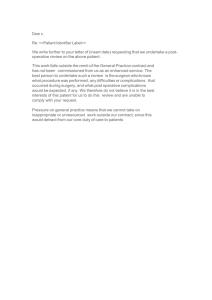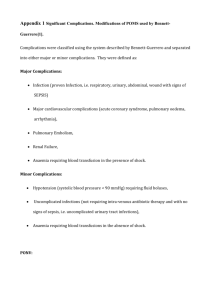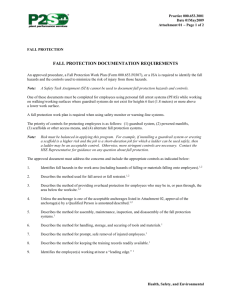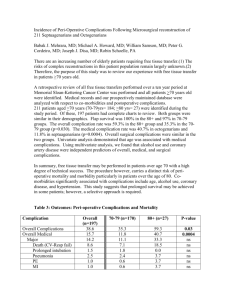Safety_60_Second_Situational Awareness UPDATED 2014
advertisement
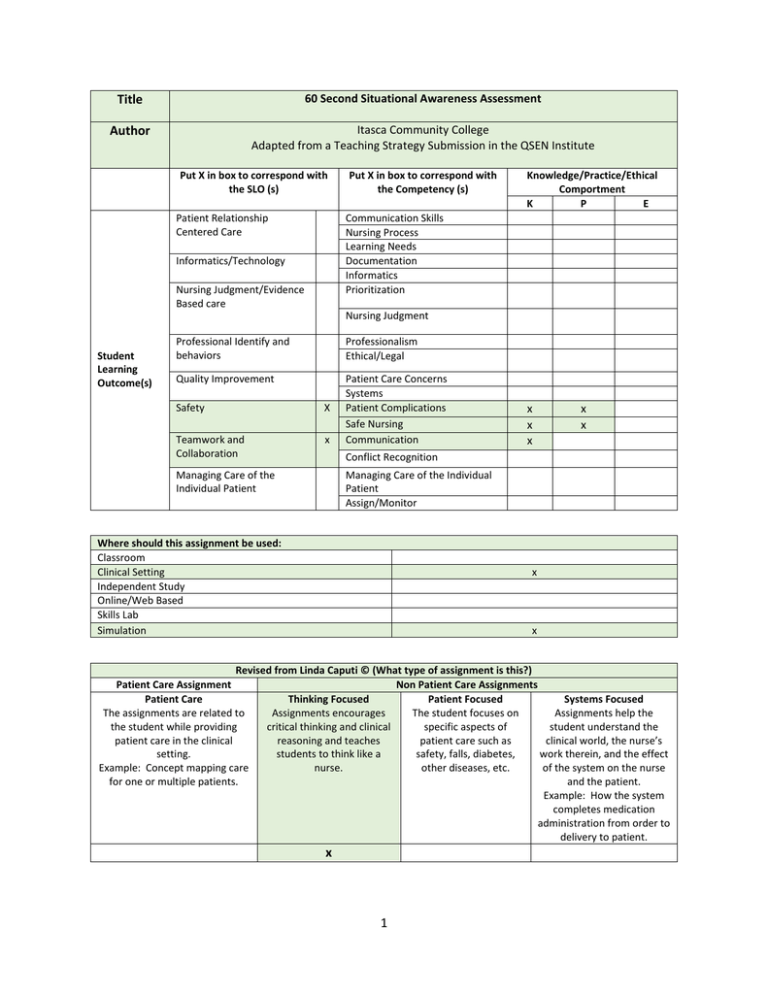
Title 60 Second Situational Awareness Assessment Author Itasca Community College Adapted from a Teaching Strategy Submission in the QSEN Institute Put X in box to correspond with the SLO (s) Patient Relationship Centered Care Put X in box to correspond with the Competency (s) Knowledge/Practice/Ethical Comportment K P E Communication Skills Nursing Process Learning Needs Documentation Informatics Prioritization Informatics/Technology Nursing Judgment/Evidence Based care Nursing Judgment Student Learning Outcome(s) Professional Identify and behaviors Professionalism Ethical/Legal Quality Improvement Patient Care Concerns Systems Patient Complications Safe Nursing Communication Safety X Teamwork and Collaboration x x x x x x Conflict Recognition Managing Care of the Individual Patient Managing Care of the Individual Patient Assign/Monitor Where should this assignment be used: Classroom Clinical Setting Independent Study Online/Web Based Skills Lab Simulation x x Revised from Linda Caputi © (What type of assignment is this?) Patient Care Assignment Non Patient Care Assignments Patient Care Thinking Focused Patient Focused Systems Focused The assignments are related to Assignments encourages The student focuses on Assignments help the the student while providing critical thinking and clinical specific aspects of student understand the patient care in the clinical reasoning and teaches patient care such as clinical world, the nurse’s setting. students to think like a safety, falls, diabetes, work therein, and the effect Example: Concept mapping care nurse. other diseases, etc. of the system on the nurse for one or multiple patients. and the patient. Example: How the system completes medication administration from order to delivery to patient. x 1 Assignment: 60 Second Situational Awareness Assessment Competencies measured in this assignment: SAFETY - PATIENT COMPLICATIONS COMPETENCY: Identify (K), implement actions (P), and recognize (E) one's responsibility to detect and respond to actual/potential patient complications and report changes to the appropriate health care provider. SAFETY - SAFE NURSING PRACTICE: Explain (K), demonstrate (P), and value (E) safe nursing practice and the relationship between national safety campaigns and implementation in practice settings. TEAMWORK AND COLLABOARTION- COMMUNICATION SKILLS COMPETENCY: Describe (K), display (P), and value (E) effective communication skills including the responsibility to report to appropriate health care personnel when working with members of the interprofessional teams. 60 SECOND SITUATIONAL AWARENESS ASSESSMENT Materials: Simulated lab environment or actual patient assessment exercise Purpose – This exercise is designed to assist you in the development of situational awareness. In the patient care area, situational awareness focuses on the art of patient observation. This includes routine use of a general survey (observation) of the patient, family and environment during every incidental encounter and periodically at planned intervals throughout the day. Situational awareness promotes a safer patient care environment and helps the nurse develop care priorities and attention to clinical detail. Directions – Enter the patient’s room and observe the patient, family and environment for up to 60 seconds, while reviewing the following questions in your mind. Complete this assessment on 4 or 5 patient’s until you feel confident with this assessment. Share your BEST assessment findings in post clinical for grading. (Preventing Complications: ABC’s without touching the patient: 1. What data would lead you to believe there is an airwaybreathing-circulation problem? 2. Is the problem urgent or non-urgent? 3. What clinical data would indicate that the situation needs immediate action and why? 4. Who needs to be contacted and do you have any suggestions/recommendations? Tubes and Lines: 1. Does the patient have any tubes, IV line, or oxygen? 2. Is the IV solution the ordered solution at the ordered rate? 1. 3. Why does your patient have these lines? 3. 4. Do you observe any complications related to these lines? 4. 5. What further assessment needs to be completed? 5. Respiratory Equipment: 1. If the patient is utilizing oxygen, what needs to be monitored? 2. How do you know if the delivery is functioning properly? 1. Patient Safety Survey: 1. What are your safety concerns with this patient? 2. Do you need to report this problem and to whom? 1. 2. 3. 4. 1. 2. 2. 2. 2 Environmental Survey: 1. Are there any environmental hazards or potential hazards that could be a risk for injury? 2. How would you manage your assessment of environmental hazards? Sensory: 1. What are your senses telling you? 2. Do you smell, see, hear, or feel something that needs further investigation? 3. Does the patient’s situation seem “right”? 1. 2. 1. 2. 3. What additional information would be helpful? What questions need further exploration? Rubric for Grading Criteria Satisfactory (__points each) Needs Improvement (__ points each) Unsatisfactory (__points each) Preventing Complications: ABC’s without touching the patient. Able to identify potential complications, urgent and nonurgent needs, who and what to report, and make recommendations for interventions. Unable to identify potential complications, needs, what to report, and suggestions to care givers without multiple cues. Tubes and Lines Able to identify why patient needs tubes, potential complications and assessments needed. Needs supportive cues to identify potential complications, urgent, non-urgent needs, who to report to and recommendations for interventions. Misses some of the questions. Needs supportive cues to identify why patient needs tubes, potential complications and assessments needed. Respiratory Able to identify if equipment is functioning properly and how to assure that it is functioning properly. Needs supportive cues to identify if equipment is functioning properly and how to assure that it is functioning properly. Patient Safety Survey Identifies safety needs of patient. Identifies what needs to be reported and what does not. Environmental Survey Identifies potential environmental hazards and identifies how to manage hazards that are found. Needs supportive cues to identify safety needs of patient. Identifies what needs to be reported and what does not with few cues. Identifies potential environmental hazards and identifies how to manage hazards that are found with supportive cues. Sensory Able to identify ¾ senses and what needs further investigating. Identifies If patient situation seems right. Able to identify 2/4 senses and what needs further investigating. Identifies If patient situation seems right. Total Points: Revised from QSEN and Itasca Community College Nursing Faculty, MN. 3 Unable to identify why patient needs tubes, potential complications and assessments needed without multiple cues. Unable to identify if equipment is functioning properly and how to assure that it is functioning properly without multiple cues. Unable to Identify safety needs of patient and unable to identify what needs to be reported and what does not. Unable to identify potential environmental hazards and how to manage hazards that are found without multiple supportive cues. Unable to identify more than 1 sense and what needs further investigating. Unable to identify if situation seems correct. 4
